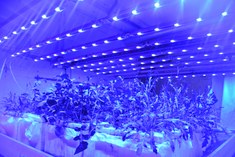Spectral light quality influences morphology, growth and nutritional value of Brassica leafy vegetables
Consumers increasingly focus on a healthy life style and are thus also interested in a healthy diet and quality food. Leafy greens belonging to the Brassicaceae family, such as rocket or rucola and Mizuna are a growing component in salads. They are rich in health promoting compounds such as polyphenols, carotenoids, glucosinolates, vitamin E and vitamin C.
LED light

The research focused on two rocket species (Eruca vesicaria and Diplotaxis tenuifolia), which form an important and growing component of packaged salad products, and Japanese mustard (Brassica rapa subsp. Nipposinica, also known as Mizuna), which is gaining popularity in Western diets. In a closed cultivation room, the effect of blue and red light ratios supplied by LED light on their leaf morphology, biomass, and nutritional value was analysed.
Increasing the blue light fraction has a positive effect on vitamin C levels in all tree crops. Still, it appears that for Eruca and Mizuna the use of broad spectrum lights (24% blue light) would offer the most benefits both to consumers as producers. Applying these lights resulted in high concentrations of nutritional interesting antioxidants and a larger, commercially interesting size of leaves. For Diplotaxis on the other hand, a 50/50 blue/red ratio promoted both antioxidant and productive qualities the most. However, when the aim is to increase vitamin C levels, Diplotaxis benefits from a transition to monochromatic blue LEDs.
This research showed that it is possible to use light to influence yield and quality for these tree Brassica leafy vegetables. Additional research is however still required to gain better insights in the effects of the light spectrum on their yields and nutritional status.
More info
- Read the full research (in Dutch)
